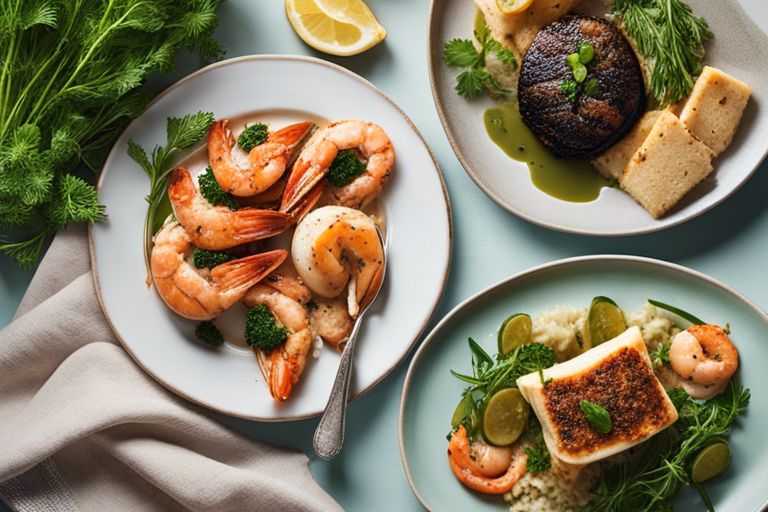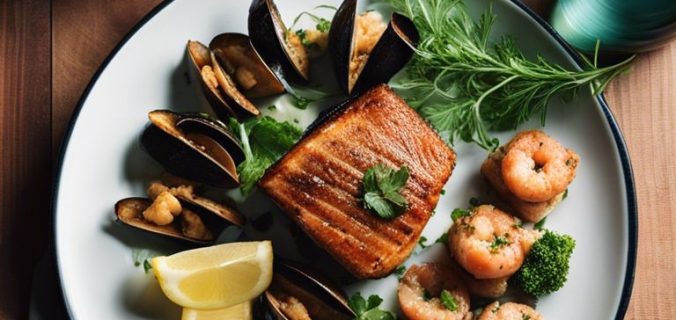Seafood lovers, rejoice! If you’re looking to enjoy the flavors and textures of seafood without the guilt or environmental impact, then seitan might just be your new favorite alternative. Seitan, also known as wheat meat, is a protein-rich meat substitute made from gluten. It’s incredibly versatile and can be shaped and seasoned to mimic various seafood dishes like fish fillets, scallops, and shrimp. Not only does seitan provide a more sustainable and cruelty-free option, but it’s also packed with protein, iron, and important nutrients. Whether you’re a longtime vegan looking to switch up your meals or a seafood lover wanting to explore plant-based options, seitan is sure to satisfy your cravings in the most delicious and guilt-free way.
Key Takeaways:
- Seitan is a plant-based alternative: Seitan is a high-protein meat substitute made from wheat gluten, providing a satisfying option for those looking to reduce their seafood consumption.
- Seitan can mimic seafood flavors: With the right seasonings and preparation methods, seitan can closely resemble the taste and texture of various seafood dishes, catering to seafood cravings in a sustainable way.
- Seitan is versatile in seafood dishes: Seitan can be used in a variety of seafood recipes such as vegan fish tacos, crab cakes, and shrimp stir-fries, offering a creative and delicious plant-based alternative.

What is Seitan?
History and Origins
The history of seitan dates back to ancient Asia, where it was created by Buddhist monks as a meat alternative. The word “seitan” itself has Japanese origins, but the concept of wheat gluten as a protein source can be traced back to China.
Nutritional Profile
The nutritional profile of seitan is impressive, as it is a great source of protein, with approximately 25 grams of protein per 3.5 ounces. It is also low in fat and carbohydrates, making it a popular choice for those looking to increase their protein intake without consuming meat.
It is important to note that seitan is not suitable for those with gluten allergies or sensitivities, as it is made from wheat gluten. However, for individuals who can consume gluten, seitan can be a valuable addition to a plant-based diet due to its high protein content and versatility in cooking.
Preparing Plant-Based Seafood Dishes with Seitan
Basic Seitan Preparation
One of the key elements in creating delicious plant-based seafood dishes with seitan is mastering the basic preparation of this versatile ingredient. Start by mixing vital wheat gluten with seasonings, such as seaweed flakes for a hint of ocean flavor, and then knead the mixture to form a dough. Boil or steam the dough until it firms up, creating a texture similar to seafood.
Recipes and Seafood Flavors
For those looking to satisfy their seafood cravings without harming marine life, seitan offers a fantastic alternative. Experiment with recipes like vegan fish tacos, crab cakes, or shrimp scampi using seitan as the star ingredient. Incorporate seafood seasoning blends, algae extracts, and Old Bay seasoning to give your dishes an authentic seafood flavor.
Recipes utilizing seitan can be a game-changer for individuals transitioning to a plant-based diet or looking to reduce their consumption of animal products. The versatility of seitan allows for a wide range of seafood dishes to be recreated in a cruelty-free and sustainable manner, all while providing a good source of protein and a satisfying texture.
Benefits of Choosing Seitan
Many individuals are increasingly looking for plant-based alternatives to satisfy their seafood cravings. One excellent option that stands out is seitan, a protein-rich meat substitute made from wheat gluten. Sysco Simply offers a range of plant-based dining products that include seitan, providing a convenient and delicious option for those seeking a sustainable and cruelty-free choice. Discover more at Sysco Simply – Plant based dining products.
Environmental Impact
Impact: Choosing seitan over seafood can have a significantly positive effect on the environment. The production of seitan requires far less water and land compared to traditional seafood farming or harvesting. Additionally, the carbon footprint of producing seitan is much lower, making it a more sustainable choice for eco-conscious consumers.
Health Advantages
The health advantages of incorporating seitan into your diet are numerous. Seitan is a high-protein, low-fat option that can aid in weight management and muscle building. It is also cholesterol-free and contains important amino acids, making it a healthy alternative to seafood. Furthermore, seitan is versatile and can be flavored and cooked in various ways to suit different taste preferences.
Incorporating Seitan in Your Diet
Tips for First-Timers
For those new to seitan, here are some tips to help you get started. Begin with small servings to see how your body reacts to this plant-based protein. Experiment with different flavors and cooking methods to find what you enjoy the most. Incorporate seitan gradually into your meals to allow your taste buds to adjust. The key is to be patient and open-minded when trying this meat alternative. The possibilities are endless, so don’t be afraid to get creative in the kitchen!
- Start with small servings
- Experiment with flavors and cooking methods
- Incorporate gradually into meals
The versatility of seitan allows you to explore various recipes and cooking techniques, making it an exciting addition to your diet. The more you experiment, the more you will discover the endless culinary possibilities of this plant-based protein. The key is to have fun while discovering new ways to enjoy seitan in your meals.
Where to Buy or How to Make Seitan
To incorporate seitan into your diet, you can either purchase it from health food stores, supermarkets, or online, or you can choose to make it at home. Making seitan at home allows you to control the ingredients and customize the flavor to your liking. This plant-based protein can be made using vital wheat gluten, spices, and broth. Follow a simple recipe to create your own batch of seitan that can be stored and used in various dishes.
This versatile meat alternative can be a game-changer in your plant-based cooking journey. Whether you choose to purchase it or make it at home, seitan offers a protein-rich and satisfying option to satisfy your seafood cravings without the need for any animal products. Experiment with different recipes to discover the endless possibilities of incorporating seitan into your diet.
Summing up
From the versatility of preparing seitan to mimic various seafood dishes to its health benefits and ethical considerations, it is clear that seitan is a fantastic plant-based option to satisfy your seafood cravings. By incorporating seitan into your diet, not only can you enjoy delicious seafood flavors, but you can also promote sustainability and reduce harm to marine life. Give seitan a try and discover a delicious and compassionate alternative to seafood today!
FAQ
Q: What is seitan and how is it a plant-based option for seafood cravings?
A: Seitan, also known as wheat meat or wheat gluten, is a high-protein meat substitute made from gluten, the main protein found in wheat. It has a chewy, meat-like texture that makes it a popular choice for plant-based diets. By seasoning and shaping seitan to mimic the taste and texture of seafood, you can satisfy your seafood cravings in a meatless way.
Q: How can I use seitan to create seafood-inspired dishes?
A: You can use seitan to make a variety of seafood-inspired dishes, such as vegan “fish” and chips, “crab” cakes, “shrimp” scampi, or even “tuna” salad. Seasoned with seaweed, Old Bay seasoning, lemon juice, and other seafood spices, seitan can take on the flavors of the ocean while remaining completely plant-based.
Q: Is seitan a healthy alternative to seafood for those following a plant-based diet?
A: Seitan is a high-protein, low-fat meat substitute that can be a healthy choice for those following a plant-based diet. It is cholesterol-free and contains no saturated fats, making it a heart-healthy alternative to seafood. However, like any food, it’s crucial to balance your diet with a variety of nutrients and not rely solely on one type of protein source.

